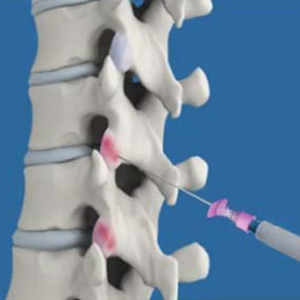Facet Joint or Nerve Injections

Pain in the neck and back can develop following injury to the spine or as a result of aging, disc degeneration, and arthritis. When this pain is severe, it may be associated with the release by the body of certain chemicals which cause inflammation and swelling. This inflammation often can be decreased simply by rest and common medications such as aspirin and Advil, or with prescription anti-inflammatory drugs. If the inflammation persists despite these treatments, cortisone may be recommended.
Cortisone (a type of steroid) is a very powerful anti-inflammatory medication. It can be administered as pills taken by mouth or with an injection. When administered by injection, the cortisone is maximally concentrated at the site of inflammation and higher doses are possible with improved effectiveness.
A facet joint or nerve injection places the cortisone into one of the joints in the spine or next to the nerve supplying the joint. Once injected, the cortisone is slowly released into the surrounding tissues and decreases inflammation, swelling, and pain. The cortisone does not cure the underlying cause of your pain. The goals of the injection are to decrease your pain to a tolerable level and to allow you to participate in rehabilitation and therapy while natural healing occurs. If you don’t notice an effect immediately following the injection, don’t become discouraged. It commonly takes 7-10 days for the cortisone to be fully effective.
The spine has many facet joints in the neck, mid, and lower back. Luckily, the source of the pain is usually confined to only a few levels on one or both sides of your spine. Your doctor will discuss with you the number of joints or nerves for which injection is planned. Often, one set of injections will result in a decrease in symptoms. If successful, however, it is difficult to predict how long the cortisone will continue to work. The injections can be repeated, but not more than 3-4 times per year.
THE PROCEDURE
The injection is performed as an outpatient. The injection takes about 15 minutes to perform. You will be positioned on your stomach. Your spine will then be washed with iodine or another antiseptic. The needles are then inserted into the facet joint/s or next to the nerve/s to the joint. The position of the needles is checked using a special X-Ray machine. Once the needles are correctly positioned, the cortisone is injected. Most patients experience very little pain either during or after the injection. After the injection, you will be gradually mobilized up to sitting and walking. A friend or relative should be with you or available to bring you home.
RISKS AND SIDE EFFECTS
Facet joint cortisone injections are very safe and usually have no side effects. There are, however, certain potential risks with which you should be familiar. Some patients experience a mild ache in the area of injection several hours after the procedure when the local anesthetic has worn off. This usually resolves rapidly and can be treated with an ice pack for 15 – 20 minutes and/or Tylenol. Allergic reaction to either cortisone or local anesthetic (xylocaine) is very rare. If you think you may be allergic to any of these medications, you must notify your doctor. The most common side effect following the injection is a small drop in your blood pressure if you get up too soon after the injection. This passes in a few minutes.
Complications from placement of the needle are rare. Infection, bleeding, and nerve damage have been reported but are very, very, rare.
Facet joint cortisone injection should not be performed if you have active infection at the site of injection, a bleeding disorder, or uncontrolled diabetes or congestive heart failure.
Relax! Most patients find that undergoing facet joint injections is much easier than they had imagined. If you have additional questions, please ask your doctor.
POST-INJECTION INSTRUCTIONS
- If you have been provided with a pain diary, be sure to complete it with your activity level and level of pain. Make entries every 30 minutes 4 – 6 hours after your procedure. Be sure to bring the diary with you to your follow-up appointment.
- Rest at home for the remainder of the day following the injection. Don’t tackle any big projects. However, you should be active enough to determine if your usual pain has decreased with the anesthetic injected into the joints. If you do experience aching in your neck or back, try an ice pack for 15 – 20 minutes or some of your usual pain medication such as Tylenol or Advil.
- The day after your injection, you may resume normal activities. But remember not to push beyond your limits.
- A follow-up appointment should have been scheduled before your procedure. If it was not scheduled, be sure to do so at the time of your procedure.
- Contact your doctor or the emergency room if you develop signs of infection (fever or redness at the site of injection), or if you notice a change in the way the nerves in your arms or legs are working (increasing numbness or weakness) or a change in your bowel or bladder function.
- Call your doctor’s office to arrange follow-up as needed.
Pre and Post Instructions
Cervical Facet Joint or Nerve Injections
Pre-Procedure Information:
- No medications need to be held prior to the injection … you may take your usual medications that day.
- These procedures are usually performed in an ambulatory surgery center but can also be done in our office procedure suite. If your procedure is scheduled in the ambulatory surgery center, sedation will be administered. If it is done in our office, your physician will prescribe oral medication to help you relax during the procedure.
- You will need to be driven to and from the procedure so make appropriate arrangements.
- If you have any questions, ask the physician prior to your procedure.
Post-Injection Instructions:
- Pay close attention to the effect numbing medicine has on your usual pain for the first 2-4 hours. If you have been provided with a pain diary, be sure to complete it with your activity level and level of pain. Make entries on an hourly basis for 4-6 hours after your procedure. Be sure to bring the diary with you to your follow-up appointment.
- Rest at home for the remainder of the day following the injection. Don’t tackle any big projects. If you do experience soreness, try an ice pack for 15-20 minutes or some of your usual pain medication such as Tylenol.
- A follow-up appointment should have been scheduled before your procedure. If it was not scheduled, be sure to do so at the time of your procedure.
- The day after your injection you may resume normal activities but remember not to push beyond your limits.
Lumbar Facet Joint Or Nerve Injections
Pre-Procedure Instructions
- No medications need to be held prior to the injection … you may take your usual medications that day.
- If you’re anxious before the injection, ask your doctor for medicine to help you relax.
- You will need to be driven to and from the procedure so make appropriate arrangements.
- If you have any questions, ask the physician prior to your procedure.
Post-Injection Instructions
- Pay close attention to the effect numbing medicine has on your usual pain for the first 2-4 hours. If you have been provided with a pain diary, be sure to complete it with your activity level and level of pain. Make entries on an hourly basis for 4-6 hours after your procedure. Be sure to bring the diary with you to your follow-up appointment.
- Rest at home for the remainder of the day following the injection. Don’t tackle any big projects. If you do experience soreness, try an ice pack for 15-20 minutes or some of your usual pain medication such as Tylenol.
- A follow-up appointment should have been scheduled before your procedure. If it was not scheduled, be sure to do so at the time of your procedure.
- The day after your injection you may resume normal activities but remember not to push beyond your limits.
